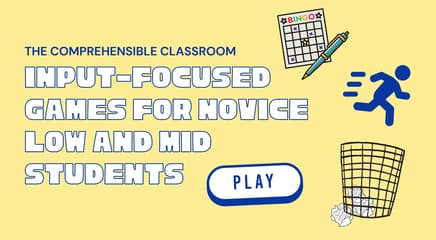It's a matching activity in disguise! Well, not so much in disguise as pretending to be cool.
'Cada oveja con su pareja' is the Spanish equivalent of 'Birds of a feather flock together'. I'd love to hear if there is a similar expression in other languages.
Matching activities are an easy way to review content through comprehensible input. However, no student wakes up in the morning thinking, "I hope that we do a matching activity in class today!" They are boring, and many students can pound them out in a few seconds flat.

Here are three ways to spice up your matching activities:
- Make it cute. It's amazing how much formatting affects students' perceptions of an activity. In this example, I made a cute worksheet with sheep on it that matches the idiomatic expression 'Cada oveja con su pareja' ("Each sheep with its pair"). Your students that are always on the hunt for new vocabulary will be happy to add a new idiomatic expression into their vocabulary, too.
- Make it communicative. Instead of giving students a worksheet, give a piece of paper with 1/2 of a matching pair to each student. The students can read their papers and show them to their classmates (which keeps the input comprehensible and correct) and try to find the classmate that has the corresponding piece of information. After each of your students has found his or her partner, have them stand together and interview them in front of the class. Ask questions to solicit more information about that excerpt from the chapter and what other conclusions can be drawn from it.
- Make it challenging. Push students to higher levels of thinking. Here are some ideas; some are basic recall and others tap into higher order thinking skills:
- Match a word with its student-friendly definition (in the target language, of course).
- Match a character with his or her description.
- Match a description of an event with its location.
- Match the first half of a sentence with the second half that best matches it. This can be taken directly from the text, or they could be paraphrases or statements about the text to make it more challenging.
- Match a character with a quote that s/he said or would say.
- Match a cause with an effect.
- Match a quote from the text with a conclusion that can be drawn from it. Consider having students identify the quotes from the text with a little symbol as an additional step to the activity.
I have created a template in Spanish that you can use for an individual or communicative activity, and it includes an example activity for Chapter 3 of Problemas en Paraíso by Carol Gaab, which is available from TPRS Publishing, Inc. I have written consent from the publisher to share this activity on my blog. In the activity, students must match each of six excerpts from the chapter with a logical conclusion, or inference, that can be drawn from it. On the answer key, the chapter excerpts are marked with a yellow circle.




